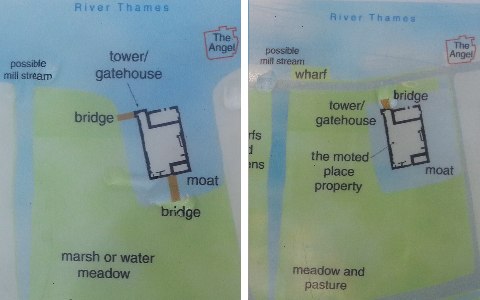King Edward III is remembered in history for starting the Hundred Years War, annexing large parts of France for England, as well as being the reigning king during the period of the Black Death. What he is infinitely less well-known for, is building a small royal residence at Rotherhithe in South East London, the remains of which can still be seen today.
When the residence was constructed in around 1350, Rotherhithe was a small hamlet set in low lying marshland. The manor house itself was built upon a small island directly next to the River Thames and consisted of a range of stone buildings around a central courtyard.
There was a moat on three sides of the complex, with the north side being completely open to the River Thames. This allowed the king to arrive by boat and at high tide to moor up against the steps that led from the river to a gatehouse located in a tower. There was also a hall with a large and imposing fireplace, the king’s private chambers, kitchens and other buildings. Further south, on drier land, was an outer court with other buildings surrounded by an earth bank.

So what was the function of this manor house? It was not a hunting lodge, since there was no attached royal park and Edward III built many hunting lodges elsewhere. Indeed, the most popular theory is that this was where the king practiced his falconry, with the birds being able to stay within eyeshot across the flat marshlands and the River Thames.
By the end of the 16th century the Thames waterfront had been pushed northwards by land reclamation, and a road had been built along the new river embankment (today this road is known as Bermondsey Wall). By this time the old king’s residence was completely enclosed by the moat, and perhaps due to a lack of enthusiasm for falconry, Edward’s ancestors eventually sold the residence and it passed into private hands.

(Left) A plan of the manor house in the 14th century (Right) A plan of the manor house in the 16th century
In the 18th century the site became used as a pottery and in the 18th and 19th centuries warehouses were built across the site. In fact the facade of the north wall of the 14th century inner court was still standing in 1907, incorporated into one of the warehouses.
In the 1970s the warehouses were demolished and in the 1980s the area was redeveloped, allowing historians at the Museum of London to excavate the remains, preserve them and make them accessible to the public.

If you’re planning on visiting the remains, then we recommend starting at the Rotherhithe underground station. You can then make a quick detour to the Brunel Museum along the way, as well as stopping in at the historic Mayflower and Angel riverside pubs.
Getting here
Easily accessible by both bus and rail, please try our London Transport Guide for help in getting around the capital.





